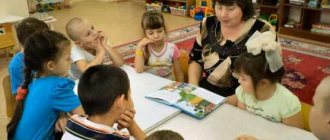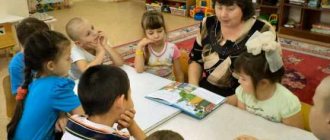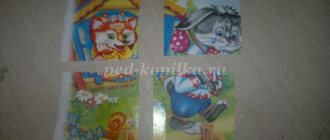The use of fiction in kindergarten classes is a powerful means of developing a harmonious personality. Reading helps improve a child's mental, aesthetic, speech abilities and skills. In the second younger group, more and more attention needs to be paid to reading, to cultivate a love of books. The lesson process itself can be structured in completely different ways - it depends on the tasks set and the topic of the chosen work.
- 2 How to read with children of the second youngest group
2.1 Organization of reading using the example of the Russian folk tale “Kolobok” - 2.2 Table: long-term plan for fiction (fragment, author Natalya Aleksandrovna Artyukhova)
- 2.3 Table: examples of GCD notes in the second junior group in fiction
The benefits of reading fiction for children 3–4 years old
In children aged 3–4 years, there is an active development of imagination and cognitive processes. The child is already able to emotionally evaluate and comprehend the texts of works: empathize with the characters, give an assessment, and draw conclusions.
Reading fiction develops imaginative thinking, fosters a love of reading, nature, and the world around us. Collective reading in a group helps the teacher to open up for children the world of relationships between people, the features of life in society.
Reading fiction develops imaginative thinking
Reading books is the path along which a skillful, intelligent, thinking teacher finds the way to a child’s heart.
V.A. Sukhomlinsky
The following goals for reading classes in the second junior group are set:
- developing a complete picture of the world;
- development of speaking skills;
- continued acquaintance with the artistic word;
- developing the ability to construct answers to questions;
- development of perception of artistic images;
- introduction to the culture of reading, the formation of a love for books;
- development of emotional reaction to events in works of art.
Books help children explore and understand the world around them
The objectives of a specific lesson may be:
- introducing children to literary works, meeting new writers;
- replenishment of vocabulary, familiarization with new words;
- developing the skill of expressive reading and intonation;
- expanding knowledge about the world around us (for example, getting to know professions while studying S. Mikhalkov’s poem “What do you have?”).
Progress of the lesson:
Children sit on chairs.
Educator: Guys, today we are going to travel through fairy tales . Let's get on the train and go.
They move around the room to the music. Every time before the train departs, the teacher reads a poem by T. Volzhina to the children:
First stop.
The train stops at the fairy tale "Kolobok"
.
With the help of the teacher, children remember the heroes of the fairy tale . The teacher asks leading questions, the children answer.
Educator: Who baked the kolobok? Who did the bun come from? Who ate the kolobok?
Sing the kolobok song with the children.
Educator: Well done, guys.
Educator: Now let's play the game "The Fox and the Hares"
.
The teacher pronounces the words, and the children perform the corresponding movements.
The bunnies sat in a circle,
They dig the root with their paw.
Suddenly a fox runs
The fox teacher is catching up with the hare guys.
Educator: And now, guys, let's get on the train and go further to another fairy tale . Let's go:
Too-too-too. I'll take you far!
Children repeat after the teacher.
Second stop: “ Tale of Teremok”
.
Educator: Now we have arrived in a fairy tale . Tell me, guys, what kind of fairy tale ?
Educator: That's right, guys. Let's remember who lives in the little house?
Educator: Who broke the tower?
Educator: That's right, guys, the bear broke it. Now let's play the game: “The bear is in the forest.”
R-r-r-y-y The teacher bear is catching up with the children
How to read with children of the second youngest group
In the second junior group, it will be useful to use the following techniques in the classroom:
- artistic expression - reading a text;
- teacher's story - here you can read the text or retell it, using various means to help: toys, puppet theater, pictures, filmstrips;
- learning by heart;
- individual reading and choral speaking;
- combining two types of arts - viewing pictures, listening to music while reading;
- staging (for example, acting out the fairy tale “Turnip” using finger toys or figurines);
- didactic games.
Should be read to children daily. There must be a book corner to which children will have constant access. There you need to place several books studied according to the program, as well as books recommended for study in your free time. At the age of 3-4 years, daily reading before bed after lunch is mandatory.
It’s better when parents also support their child’s involvement in reading.
Before reading a work to children, the teacher should read it himself and analyze it. Here you need to pay attention to the following points:
- Determine what the child can understand on his own in the book, and what needs to be explained for better assimilation.
- Mark passages and words in the text that will help develop speech when they are repeated (for example, the teacher reads the passage: “Little goats, kids! Open up, open up! Your mother came and brought milk...” (“The Wolf and the Seven Little Kids”), then reads some more times the phrase and asks the guys to finish it).
- Intonation moment: the teacher should highlight emotional moments with intonation.
- Selection of illustrations for the book.
Conducting a more comfortable lesson without overloading children with unnecessary information and fatigue will be facilitated by:
- changing teaching techniques with game ones (for example, after reading S. Marshak’s poem “The Tale of a Stupid Mouse,” you can play the game “Find the Mouse”);
- alternation of group and individual responses of children (both verbal and motorically expressed);
- inclusion of demonstration materials (toys, figurines, drawings, etc.) into the lesson - this pleases the kids and helps focus their attention;
- using actions that will require the children to change their position, move (for example, “Children, let’s look where the cat hid” - and look under chairs and tables). This technique significantly enlivens the activity, enlivens the child’s imagination and prevents fatigue.
Organization of reading using the example of the Russian folk tale “Kolobok”
The objectives of the lesson are to introduce the children to the fairy tale “Kolobok” and teach them word formation.
It is easier for children of primary preschool age to perceive text accompanied by illustrations
The lesson can be structured as follows:
- Introductory part. The teacher conducts a conversation with the children, asks who Kolobok is, whether the children have heard of him before (from home reading, cartoons).
- Then reading an excerpt from a fairy tale: “I kneaded the dough with sour cream, rolled it into a bun...” (kids demonstrate with their hands how to make a bun).
- Expressive reading of a fairy tale (here it is worth emotionally highlighting the moments of joy when Kolobok manages to escape from the animals so that the children rejoice, and the moment of grief when the fox deceived him with her cunning).
- The teacher repeats with the children what different animals said to the kolobok (“Kolobok, kolobok, I’ll eat you!”).
- Word game (“Guys, now let’s play! I will tell you words that denote a large object, and you will say words that denote the same objects, only smaller: table - table, cup - cup”).
- Then the teacher shows the children drawings for the fairy tale “Kolobok”, saying that many famous artists have depicted Kolobok.
The teacher must make full use of the necessary methodological techniques for mastering the material, developing listening skills, and reading comprehension. Expressive reading of a work helps children better remember the material and evaluate it. When discussing what you read, you can use a comparison of a situation in a book with a comparison of a real-life incident, and give hints when answering.
Expressive reading will help you remember the material better
When choosing a topic for a lesson, it will be very useful to associate it with some holiday or time of year for the children to better assimilate the material.
Table: long-term plan for fiction (fragment, author Natalya Aleksandrovna Artyukhova)
| Month | Subject | What are the lessons aimed at? |
| September | Poem “The Preacher” by Sasha Cherny |
|
| Russian folk tale "Cat, Rooster and Fox" |
| |
| Russian folk tale "Three Bears" |
| |
| October | Reading the Russian folk tale "Kolobok" |
|
| Reading poems by A. Barto from the “Toys” cycle |
| |
| Reading poems by A. Blok “Bunny” and A. Pleshcheev “Autumn” |
| |
| November | Russian folk nursery rhymes “Kitsonka-murysenka”, “The cat went to market” |
|
| Russian folk tale “Sister Alyonushka and Brother Ivanushka” |
| |
| Reading poems about mom |
| |
| Reading a fairy tale in verse by K.I. Chukovsky "Moidodyr" |
| |
| December | Russian folk tale "Masha and the Bear" |
|
| S.Ya. Marshak "The Tale of a Stupid Mouse" |
| |
| Russian folk tale "The Fox and the Wolf" |
| |
| January | L. Voronkova story “It’s snowing” | Introduce a work of art, reviving in the children’s memory their own impressions of the snowfall. |
| Russian folk tale "The Snow Maiden and the Fox" |
| |
| E. Charushin story “Wolf” |
| |
| February | Russian folk tale "The Wolf and the Seven Little Goats" |
|
| Z. Aleksandrova’s poem “My Teddy Bear” |
| |
| Russian folk tale "Rukavichka" |
| |
| Russian folk tale "The Cockerel and the Bean Seed" |
| |
| March | E. Blaginina, poem “This is what a mother is like” |
|
| Reading of A. Pleshcheev’s poem “Spring” |
| |
| Russian folk tale “Fear has big eyes” |
| |
| L. N. Tolstoy's story “Truth is more precious than anything else” |
| |
| April | Reading the Russian folk tale "Geese and Swans" |
|
| K. Chukovsky reading the story “Chicken” |
| |
| Russian folk tale “Bull-black barrel, white hooves” |
| |
| May | Reading the story “Holiday” by Ya. Taits |
|
| V. V. Mayakovsky “What is good - what is bad?” |
| |
| S. Marshak poem “Children in Cages” |
|
In pedagogical practice, there is a huge amount of materials to help teachers conduct classes.
Table: examples of GCD notes in the second junior group in fiction
| Author and title of the abstract | Description of material |
| Tatiana Osipova. “Reading the Russian folk tale “Geese and Swans” | Notes on reading the Russian folk tale “Geese and Swans” (aimed at the general artistic development of children, and also serves other educational purposes). |
| Ksenia Yakovleva. “Reading the fairy tale “The Wolf and the Seven Little Goats” | The notes will help in planning a fairy tale reading lesson, the purpose of which is to instill in children a love for animals and teach them to empathize with them. |
| Olga Yantsen. “Reading the fairy tale “Kolobok” | The summary is aimed at developing spoken language in children of the second younger group. |
| Galina Kochulova. Integrated lesson in the second junior group on familiarization with fiction “Teremok” | Lesson summary using non-traditional appliqué technique (“Palms”). |
Stories for little ones Ya. Taits
Story by Ya. Taits “Geese”
My grandmother had geese on the collective farm. They hissed. They pinched. They were talking to each other: “Ha-ha!” "Ha-ha!" “Yeah!” "Ha-ha!" “Yeah!” Nadya was afraid of them. She shouted: “Grandma, geese!” Grandma said: “You take a stick.” Nadya took a stick, and how could she swing at the geese? - Get out of here! The geese turned and walked away. Nadya asked: “Are you scared?” And the geese answered: “Aha!”
Story by Ya. Taits “Train”
There's snow everywhere. Masha has a sled. Misha has a sled. Tolya has a sled. Galya has a sled. One dad without a sled. He took Galina's sled, hitched it to the Tolins, Tolina - to the Mishins, Mishins - to the Mashins. It turned out to be a train. Misha shouts: - Tu-tu! He is a machinist. Masha shouts: “Your tickets!” She's a conductor. And dad pulls the string and says: “Choo-chuh... Chuh-chuh... So he’s a locomotive.”
At the age of 1 year 6 months to 2 years, it is very important to start teaching a child to listen to stories without visual support - that is, without showing pictures based on the content of the story, without dramatizing or showing toys. I have made a selection of such stories for children, which they understand from the content itself. In the collection, the stories are grouped by age: from 1 year 9 months to 2 years, from 2 years to 2 years 6 months, from 2 years 6 months to 2 years 11 months.
Making a laptop based on fairy tales
The supplementary guide is called a lapbook. This is a visual aid that contains all the information about the work, interesting facts and illustrations.
The laptop was invented to supplement knowledge about the work. This material allows you to give free rein to your imagination. With its help, you can make theatrical performances, ask riddles and ask each other questions about the text.
- According to a specific fairy tale;
- For several works;
- For the section on fairy tales with mixed plots.
Example of a lapbook “Through the pages of fairy tales”
They add to it:
- Character images;
- Picture hints for retelling;
- Coloring books;
- Games;
- Puzzles;
- Proverbs;
- Devices for the theater (pictures on sticks, on fabric, tabletop).
Important! Additionally, there may be tasks related to the section studied, for example: guessing the name of a fairy tale and the writer based on the illustration, naming the characters based on the title of the work. In older groups, students are asked to solve a crossword puzzle based on the fairy tale they have studied.
In the younger group, various interesting quizzes are held. They help the baby develop speech and fight inhibitions. Closed guys begin to behave more relaxed in society.



